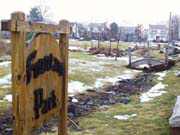Seven years after the demolition of the Keystone Metal Finishing factory on Humboldt Avenue and Raydol Street, town officials are once against contemplating the property’s fate, seeking ways to fund cleanup of contamination on and off the site as well as putting the property back on the tax roles.
Mayor Dennis Elwell said this week that the town was examining the possibility of auctioning off sections of the property for construction of residential homes.
“It is a proposal for the Town Council to consider,” Elwell said. “It is feasible that we can auction some of the land at Keystone along with the former DPW on Golden as a way to defray the cost of the cleanup to the taxpayer.”
It could cost as much as $800,000 to implement plans submitted to the council last summer to inject special chemicals into the ground to clean up contamination on and off the Keystone site, Elwell said.
“We’re are looking into auctioning off some of the land for one- or two-family homes,” Elwell said.
Sections of land, he said, could be sold for the construction of homes. This would have the double benefit of bringing the town immediate funds to offset the cost of cleanup and putting the property back on the tax rolls.
Such plans had been rumored in the past, but had previously been considered unlikely because of the groundwater contamination.
Richard Manney, when still the town’s health officer in 1994, said with the contamination the land would likely be used for other purposes, such as a public building or a strip mall in which people would not live 24 hours a day.
But with the proposed cleanup that could significantly reduce or eliminate the contamination under the Keystone property itself as well as the homes around it, residential housing may be possible.
Sold for more
Elwell noted that the contamination has not affected resale values in the area, despite claims to the contrary. One home in the projected contamination plume had actually sold for $40,000 higher than purchase price.
Elwell said more will be reported at the Keystone Committee meeting slated possibly for February. During that meeting, the town will present definitive maps showing the exact extent of the contamination, and will then clear the way to move ahead with the larger project of cleaning up the neighborhood.
Elwell said the contamination was not considered a health risk to residents but that the town had moved ahead with cleanup plans. The town does have the option of giving the land to the state to clean up, but the town would lose the potential taxes from the land, and it might take longer to clean it up.
“The contamination is not considered a health hazard,” he said. “If the state were to take over and clean it up, they would give it a low priority.”
Currently, the Keystone property is being used as a park constructed as a result of efforts by former Mayor Anthony Just, although some people had pushed to build homes there after demolition of the factory in 1994.
While no one in the neighborhood regrets the town’s move to tear down the 50-year-old Keystone Metal Works building with its rusting metal ducts, broken brick and corrosives slowly seeping into the soil and water supply, some residents opposed the park because of previous negative experiences with a playground in the area years earlier, when kids hung out after dark, blasting music and fighting. Barbara Napierski – a resident living across from the Keystone site – has reported similar problems since the park’s construction.
This is not the first time the property has been proposed for housing. Town officials said a plan for multiple residents had been proposed in the late 1980s. But the plan fell through because the number of units exceeded zoning density limits and residents in the area complained about the change the project would bring to the neighborhood.
Mayor Paul Amico, who served as mayor for 28 years before leaving office in 1991, recommended that the land be divided into parcels and auction them off to the highest bidders for the development of one and two family homes. A decade later, town officials seemed to have taken his advice.
“We always believed that some of the land should be used for housing,” Elwell said. “But that doesn’t mean we will get rid of the park. We’re only talking about developing a few of the parcels. There will still be room for the park.”
